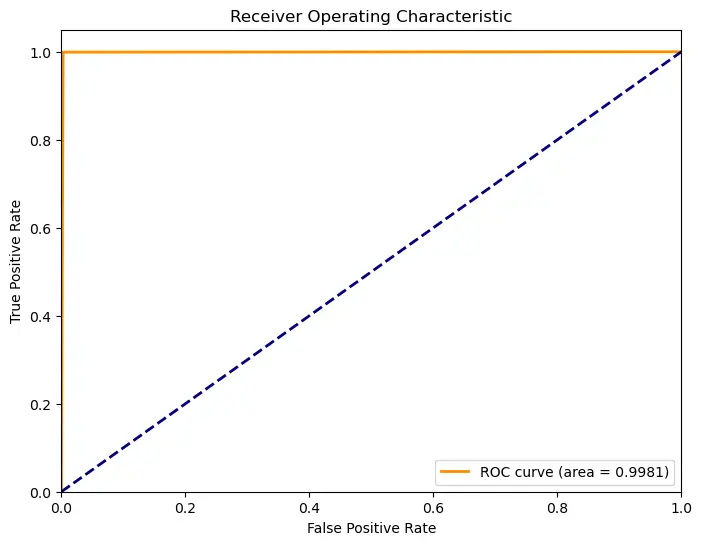决策树
概述
决策树是一种常用的监督学习算法,适用于分类和回归任务。它通过一系列的决策规则将数据集划分成更小的子集,从而形成一个树状结构。决策树模型具有高度的解释性,能够直观地展示决策过程。
决策树的基本形式
节点类型:
- 决策节点:表示对某个特征的测试。
- 叶节点:代表分类结果或回归输出。
生成过程:
- 选择最佳特征进行数据划分,常用的准则包括信息增益、信息增益率和基尼指数。
- 递归地在每个子集上进行上述过程,直至满足停止条件(例如,节点纯度达到阈值或树深度限制)。
决策树的特性
- 简单直观:易于理解和解释,特别适合展示复杂决策逻辑。
- 灵活性:能够处理数值型和类别型数据,并且不要求特征间的线性关系。
决策树的优缺点
优点:
- 解释性强:可以清晰地展示决策路径。
- 无需数据预处理:不需要特征缩放或归一化。
- 能够处理多种数据类型:包括数值和类别数据。
缺点:
- 易过拟合:特别是在树的深度不加限制时。
- 不稳定性:小的扰动可能导致树结构的显著变化。
- 偏差-方差权衡:单一决策树可能不足以捕获数据的复杂模式,通常结合集成方法(如随机森林)来提升性能。
与其他模型的比较
- 与线性模型相比:决策树无需假设数据的线性关系,更适合非线性和复杂的决策边界。
- 与神经网络相比:决策树模型更易于解释,但对复杂模式的捕捉能力相对较弱。
应用与扩展
- 应用场景:广泛用于金融风险评估、医疗诊断、市场营销等领域。
- 扩展方法:通过集成技术(如随机森林、梯度提升树)提高模型的泛化能力和稳定性。
总之,决策树是一种强大的模型,提供了良好的可解释性和灵活性。在现代机器学习中,决策树的变体和集成方法进一步增强了其应用广度和深度。
实践
介绍如何使用 Scikit-learn 构建一个简单的决策树模型,以检测信用卡交易中的欺诈行为。此流程涵盖了数据加载、预处理、模型训练和评估等步骤。
数据集
使用 Kaggle 数据集 Credit Card Fraud Detection Dataset 2023,该数据集包含 2023 年欧洲持卡人的信用卡交易。该数据集包含超过 55 万条记录,为保护持卡人身份,数据已进行匿名化处理。该数据集的主要目的是促进欺诈检测算法和模型的开发,以识别潜在的欺诈交易。
导入库
导入所需的库,包括用于数据处理的 Pandas,数据可视化的 Seaborn 和 Matplotlib,以及用于模型训练和评估的 Scikit-learn。
import pandas as pd
import seaborn as sns
import matplotlib.pyplot as plt
from sklearn.model_selection import train_test_split
from sklearn.metrics import confusion_matrix, roc_curve, auc, classification_report
from sklearn.tree import DecisionTreeClassifier as DTC, plot_tree加载数据
使用 Pandas 加载数据集,并显示前五行数据:
df = pd.read_csv('../kaggle/input/creditcard_2023.csv')
df.head(5)| id | V1 | V2 | V3 | V4 | V5 | V6 | V7 | V8 | V9 | ... | V21 | V22 | V23 | V24 | V25 | V26 | V27 | V28 | Amount | Class | |
|---|---|---|---|---|---|---|---|---|---|---|---|---|---|---|---|---|---|---|---|---|---|
| 0 | 0 | -0.260648 | -0.469648 | 2.496266 | -0.083724 | 0.129681 | 0.732898 | 0.519014 | -0.130006 | 0.727159 | ... | -0.110552 | 0.217606 | -0.134794 | 0.165959 | 0.126280 | -0.434824 | -0.081230 | -0.151045 | 17982.10 | 0 |
| 1 | 1 | 0.985100 | -0.356045 | 0.558056 | -0.429654 | 0.277140 | 0.428605 | 0.406466 | -0.133118 | 0.347452 | ... | -0.194936 | -0.605761 | 0.079469 | -0.577395 | 0.190090 | 0.296503 | -0.248052 | -0.064512 | 6531.37 | 0 |
| 2 | 2 | -0.260272 | -0.949385 | 1.728538 | -0.457986 | 0.074062 | 1.419481 | 0.743511 | -0.095576 | -0.261297 | ... | -0.005020 | 0.702906 | 0.945045 | -1.154666 | -0.605564 | -0.312895 | -0.300258 | -0.244718 | 2513.54 | 0 |
| 3 | 3 | -0.152152 | -0.508959 | 1.746840 | -1.090178 | 0.249486 | 1.143312 | 0.518269 | -0.065130 | -0.205698 | ... | -0.146927 | -0.038212 | -0.214048 | -1.893131 | 1.003963 | -0.515950 | -0.165316 | 0.048424 | 5384.44 | 0 |
| 4 | 4 | -0.206820 | -0.165280 | 1.527053 | -0.448293 | 0.106125 | 0.530549 | 0.658849 | -0.212660 | 1.049921 | ... | -0.106984 | 0.729727 | -0.161666 | 0.312561 | -0.414116 | 1.071126 | 0.023712 | 0.419117 | 14278.97 | 0 |
确保数据集的完整性:
df.info()输出
<class 'pandas.core.frame.DataFrame'>
RangeIndex: 568630 entries, 0 to 568629
Data columns (total 31 columns):
# Column Non-Null Count Dtype
--- ------ -------------- -----
0 id 568630 non-null int64
1 V1 568630 non-null float64
2 V2 568630 non-null float64
3 V3 568630 non-null float64
4 V4 568630 non-null float64
5 V5 568630 non-null float64
6 V6 568630 non-null float64
7 V7 568630 non-null float64
8 V8 568630 non-null float64
9 V9 568630 non-null float64
10 V10 568630 non-null float64
11 V11 568630 non-null float64
12 V12 568630 non-null float64
13 V13 568630 non-null float64
14 V14 568630 non-null float64
15 V15 568630 non-null float64
16 V16 568630 non-null float64
17 V17 568630 non-null float64
18 V18 568630 non-null float64
19 V19 568630 non-null float64
20 V20 568630 non-null float64
21 V21 568630 non-null float64
22 V22 568630 non-null float64
23 V23 568630 non-null float64
24 V24 568630 non-null float64
25 V25 568630 non-null float64
26 V26 568630 non-null float64
27 V27 568630 non-null float64
28 V28 568630 non-null float64
29 Amount 568630 non-null float64
30 Class 568630 non-null int64
dtypes: float64(29), int64(2)
memory usage: 134.5 MB查看目标变量 Class 的分布情况
df["Class"].value_counts()输出
Class
0 284315
1 284315
Name: count, dtype: int64数据预处理
去除不需要的列,然后将数据集划分为训练集和测试集。值得注意的是,决策树模型不要求输入数据进行标准化或归一化,因为它基于树结构,不受特征尺度的影响。
X = df.drop(['id', 'Class'], axis=1)
y = df.Class
X_train, X_test, y_train, y_test = train_test_split(X, y, test_size=0.2, random_state=42)构建和训练模型
定义并训练决策树模型:
dtc = DTC(random_state=42)
dtc.fit(X_train, y_train)可视化决策树
plt.figure(figsize=(20, 5))
plot_tree(dtc, filled=True, feature_names=X.columns, class_names=["No Fraud", "Fraud"], rounded=True, fontsize=8, max_depth=3)
plt.title("Decision Tree")
plt.show()
模型评估
进行预测并使用 classification_report 输出评估指标:
y_pred = dtc.predict(X_test)
print(classification_report(y_test, y_pred, target_names=["No Fraud", "Fraud"], digits=4))| precision | recall | f1-score | support | |
|---|---|---|---|---|
| No Fraud | 0.9990 | 0.9972 | 0.9981 | 56750 |
| Fraud | 0.9972 | 0.9990 | 0.9981 | 56976 |
| accuracy | 0.9981 | 113726 | ||
| macro avg | 0.9981 | 0.9981 | 0.9981 | 113726 |
| weighted avg | 0.9981 | 0.9981 | 0.9981 | 113726 |
绘制混淆矩阵
cm = confusion_matrix(y_test, y_pred)
plt.figure(figsize=(8, 6))
sns.heatmap(cm, annot=True, fmt="d", cmap="Blues",
xticklabels=["Predicted No Fraud", "Predicted Fraud"],
yticklabels=["Actual No Fraud", "Actual Fraud"])
plt.ylabel('Actual')
plt.xlabel('Predicted')
plt.title('Confusion Matrix')
plt.show()
计算并绘制 ROC 曲线和 AUC 值:
fpr, tpr, thresholds = roc_curve(y_test, y_pred)
roc_auc = auc(fpr, tpr)
plt.figure(figsize=(8, 6))
plt.plot(fpr, tpr, color='darkorange', lw=2, label='ROC curve (area = %0.4f)' % roc_auc)
plt.plot([0, 1], [0, 1], color='navy', lw=2, linestyle='--')
plt.xlim([0.0, 1.0])
plt.ylim([0.0, 1.05])
plt.xlabel('False Positive Rate')
plt.ylabel('True Positive Rate')
plt.title('Receiver Operating Characteristic')
plt.legend(loc="lower right")
plt.show()
